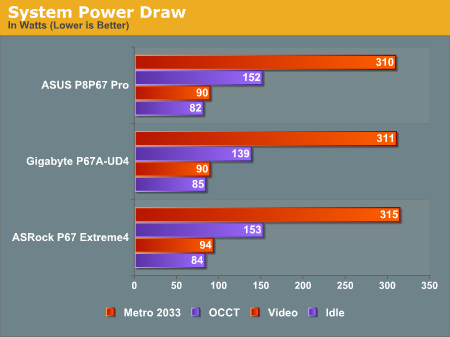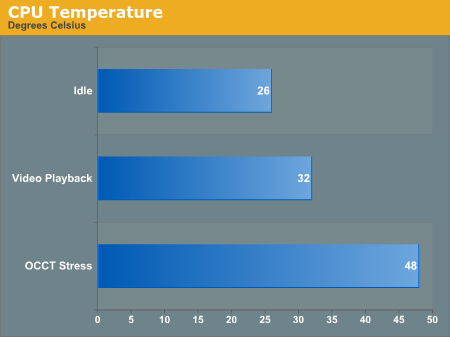Welcome to Sandy Bridge, with the ASRock P67 Extreme4
by Ian Cutress on January 3, 2011 7:00 AM EST- Posted in
- Motherboards
- ASRock
Overclocking
Overclocking on Sandy Bridge is significantly easier than on previous platforms. With only the multiplier to play with, it is a case of finding the correct balance of multiplier and voltage.
Using the AXTU software bundled with the motherboard, I simply pushed the multiplier up to 44x (4.4GHz) without any issues. At this speed, the CPU would declock to 4.0GHz when OCCT was running, indicating that we were hitting the power draw limit automatically determined by the motherboard. On 4.5GHz, the system would BSOD when starting the OCCT stress tool, indicating that not enough voltage was being supplied to the processor.
In the UEFI, due to the auto overclocking settings offered, I set the system to boot at 4.6GHz. In the OS, this set a voltage of 1.378V, and ran an OCCT stress test fine, showing a maximum temperature of 70ºC (Idle 37ºC). At the 4.8GHz setting, we got 1.49V through the processor, but a failed OCCT stress test. On the next boot, I had to reset the UEFI to get it to stay stable while changing settings.
In my wisdom, and by delving into the UEFI settings, I ventured forth to manipulate the multiplier and voltages personally. I booted into Win7 with 4.5GHz, 1.4V on VCore and 1.9V on CPU PLL (for some headroom), and turned off Load Line Calibration. However, the OCCT stress test also resulted in the CPU declocking automatically. In order to get this to stop, I had to turn on Intel SpeedStep, and increase the Long Duration Power Limit from 95W to 110W. With this, I hit 4.6GHz and 4.7GHz (hitting 73 ºC, and reducing to 4.6GHz so I increased the power to 120W). For 4.8GHz, I pushed VCore to 1.45V, and the power limits to 150W (short) and 130W (long)—this gave a stable OCCT at 80ºC but would randomly BSOD. At these settings, 4.9GHz would not boot into the OS, and I was not willing to push them further.
4.6GHz using the UEFI settings seems like the best bet for any user wanting a simple 24/7 overclock. The 3D Movement multithreaded benchmark rose from a stock score of 341.74 to 451.84.
Power Consumption and CPU Temperatures
Power consumption was tested on the system as a whole with a wall meter connected to the power supply, using a dual GPU configuration. This method allows us to compare the power management of the UEFI and the board to supply components with power under load, and includes typical PSU losses due to efficiency. These are the real world values that consumers may expect from a typical system (minus the monitor) using this motherboard.


The Extreme4 doesn't do too badly in power consumption readings compared to the other boards. It ends up slighly higher under heavy loads, but the differences are small enough that we can't see power requirements being a selling point one way or another yet.










55 Comments
View All Comments
GTVic - Monday, January 3, 2011 - link
On page 3 there is a BIOS version listed?cmdrdredd - Monday, January 3, 2011 - link
no SATA 6Gbps, only two 8x PCIe lanes not two 16x, and it's generally low end.IanCutress - Wednesday, January 5, 2011 - link
The PCIe bandwidth for P67 is double that of P55/X58, so an 8x here is equivalent to an old 16x. A lot of people gloss over this fact, similar to wondering why the 6xxx cards have less SPs than 5xxx counterparts - it's an architectural change.Ian
drvelocity - Monday, January 3, 2011 - link
Why was the ASUS p8p67 getting spanked so hard in the single GPU tests? Any insight on that?Spivonious - Tuesday, January 4, 2011 - link
Please stop stating that mouse use is something new. I could use the mouse in the BIOS setup of my Tyan 440BX motherboard in 1998.Also, you state that you prefer two ethernet ports but never explain why. Unless you're using the computer as a gateway, why do you need more than one?
IanCutress - Wednesday, January 5, 2011 - link
We never state that using a mouse is something new. We state it's an improvement or a major benefit over the majority of previous BIOS implementations, especially in the last ten years of mainstream computing and to most consumers.In terms of dual Ethernet ports, there are many options:
1) Link Aggregation
2) Large format printers/plotters
3) Various file/server systems require a second NIC for metadata
It's true 99.99% of people won't need it, but for the low price of the chip, it's not too much to ask. Ideally, we'd want the Intel NIC every time - it's more configurable.
Ian
Spivonious - Wednesday, January 5, 2011 - link
"Major benefits include a graphical interface, the ability to use a mouse..."Maybe you didn't mean to, but it definitely implies that these things are new with UEFI.
1) Gigabit switches are under $30. The average broadband connection is well under 100Mbps. There is also very limited support for link aggregation in consumer-level products.
2) Yeah, let me pull that one out of the closet. Again, P67 is targeted at home users.
3) Can you name a few? And again, the average home user might have a simple file/media server.
I would be surprised if the next X series boards don't feature dual ethernet ports, but to mention it more than once on a board targeted towards the midrange is more than a bit silly.
IanCutress - Saturday, January 8, 2011 - link
P67 may be targeted at home users, but industry will look at it as well as a viable option, regardless of where it's targeted. It's easy to get roped into a home-users own little world when that's the only thing that maybe important to you. As a reviewer, it's important not to overlook that fact.The point we make is that it is easy enough for a manufacturer to increase the range of appeal of the hardware, by adding a small hardware element for which there is space. If you read through recent Anandtech motherboard reviews, there is a trend for industry level readers to take note of various products we review and add comments on the benefits/drawbacks certain products have for their line of industry, regardless of where the board is actually aimed for. This is why we cover things like dual Ethernet in reviews.
Ian
mapesdhs - Wednesday, January 5, 2011 - link
I could use a mouse for my SGI's equivalent setup in 1992. :D
Ian.
ibudic1 - Tuesday, January 4, 2011 - link
Thank you for posting your benchmark. We do 3D rendering, and some 3D computation (planned), and your benchmark makes sense for us.If I were to produce a benchmark for you to test would you be interested?